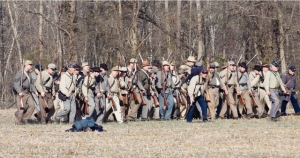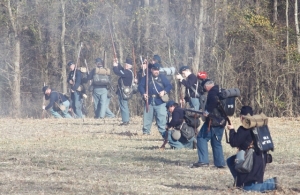A battle comes to life -- 150 years later
By Kenneth Fine
Published in News on December 16, 2012 1:50 AM

News-Argus/BOBBY WILLIAMS
Confederate troops advance on the Union position during Saturday's re-enactment of the Battle of the Goldsborough Bridge.

News-Argus/BOBBY WILLIAMS
Union troops return fire during Saturday's re-enactment of the Battle of the Goldsborough Bridge.
The thick black cloud rising into a section of Wayne County sky did not dissipate when Confederate soldiers belted out their rebel yell.
The sound of Union muskets did not subside.
The streaks of light that accompanied burning fuses continued to flicker across a battlefield enveloped in smoke.
The day belonged to the invaders.
It has been 150 years since some 15,000 men fought on a 600-acre tract of farmland -- along river banks and across a vast ridge; next to a strategic bridge that, by day's end, was broken and burned.
But those who gathered this weekend at the site of what could have been a significant Civil War engagement to honor the sacrifices made Dec. 17, 1862, seemed to agree that despite the outcome, the Battle of the Goldsborough Bridge is well worth remembering -- that Union or Confederate, the boys who lost their lives that day were heroes.
*
Union troops began their march through eastern North Carolina six days earlier.
Most of them were simple men -- nine-month volunteers from Massachusetts, New York, Rhode Island, Connecticut and New Jersey, who, according to Randy Sauls, a local historian and founder of the Goldsborough Bridge Battlefield Association, had likely not been battle-tested.
Their journey was grueling.
"We know that every night of the march .... the men's water in their canteens froze," Sauls said. "And we know they didn't have tents."
So they slept under the stars with their feet facing camp fires -- clinging to whatever warmth they could find.
Their objective was simple.
"It has a lot of national significance because it was part of the Fredericksburg Campaign. The Battle of Fredericksburg took place just four days prior ... but they were meant to be a simultaneous action. The idea was that Gen. (John) Foster would march from New Bern, destroy the railroad bridge at Goldsborough and bottle up all the supplies coming from the deep south and Wilmington. At the same time, Gen. (Ambrose) Burnside would attack (Gen. Robert E.) Lee's army at Fredericksburg and ... the plan was that Burnside would defeat Lee's army and then Lee would be denied resupply by this bridge being burned."
Success could have meant the fall of Richmond and an end to the war.
"It didn't work out that way," Sauls said. "Fredericksburg ended up being a disaster for the Union."
But Foster's troops had no idea what had unfolded in Virginia.
As far as they knew, defeating the North Carolina regiments at Goldsborough -- the 8th, 51st, 52nd and 61st -- and destroying the railroad bridge they were protecting was still a no-fail mission.
*
Dec. 17, 1862, was unusually warm for a winter morning in the South.
"The day of the battle was probably very much like this," Sauls said, moments after he commented on how he had worked up a sweat during his walk across the grounds. "The New England men thought it was hot. They were thinking Christmastime in Massachusetts is very different than this."
But the climate wasn't a factor when the fighting began.
"What you would see, from about 10 in the morning to 11 in the morning, you would see a great deal of artillery from the southeast toward the northwest -- toward the railroad bridge. You would see shells going through the air and they have a fuse as they're burning so you would see a little streak of light," Sauls said. "There would be a lot of concussion. It would be very, very loud. There would be a whole lot of smoke on the battlefield and you would hear musket fire from the other side of the railroad, and where we're standing right now, on top of the railroad embankment right here, you would see the 17th Massachusetts Infantry Regiment just along the tree line here fighting their way up."
By early afternoon, Union forces had closed in on their target.
"That when on until about 2 o'clock. Then, the two lead infantry regiments, the 9th New Jersey the 17th Massachusetts, had made it within a few yards of the bridge," Sauls said.
So Foster pulled up his artillery and began bombarding the north bank of the river, "to try to keep the Confederates' heads down."
"Then, this assault party of six or seven men runs forward and they set fire to the bridge," Sauls said. "So you would see a huge column of black smoke. You would still hear the concussion and explosions from all these artillery rounds. There was still musket fire coming from the north bank of the river. And then, everything sort of got quiet."
The bridge now burning, Foster's men began tearing up the railroad tracks, and by 4:30, left the battlefield.
They had no idea that two North Carolina regiments were gearing up for a counterattack.
"That's when the 51st and 52nd come out of the tree line, across the field ... and that's when they attack," Sauls said. "But when they went down the embankment, they gave the rebel yell."
Their cries alerted the Union forces.
"They were mowed down at that point," Sauls said. "That's where most of the causalities in this battle occurred."
*
It was the early 1990s, more than 130 years after the battle, when Sauls took his first trip to the site.
"At that time, of course, this was a horse farm," he said. "It was a pretty sad sight, but it had been left alone. It had not been developed, but it hadn't been lost either."
So with the county government's blessing, Sauls and other members of the organization he founded worked tirelessly to restore the battlegrounds -- their way of paying homage to those who gave their lives there more than a century ago.
"It's just very, very rewarding. It's very meaningful to me," Sauls said. "As far as the men who fought and died here, I think about them all the time -- especially when I'm out here by myself.
"It's particularly interesting to be out here by yourself -- to be in the woods walking the trail out there -- and when it's quiet, you kind of catch the moment a little bit."
And every once in a while, if you're lucky, a train comes chugging down the track.
"Every time that train comes by, I always think, that's why we're here," Sauls said. "But for that train ... this would not have occurred.
"You know, the Battle of the Goldsborough Bridge, it was a wonderful tactical success for the Union, but strategically, it ended up having very little value ... because Fredericksburg was a disaster. Now, had Fredericksburg been a victory ... and had Lee been defeated, this could have had a huge impact on the war. It wouldn't have ended it, at least immediately, but it might have shortened it. I guess we'll never know."
